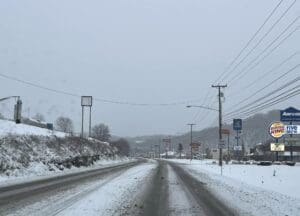Frigid temps and low pavement temps create travel challenges, impact salt material effectiveness
FRANKFORT, Ky. (Jan. 15, 2024) – Many Kentucky highway crews have been active since the weekend pre-treating roads and they continue to monitor weather conditions and respond as needed to keep traffic flowing on state-maintained roads. The combination of below-freezing air and pavement temperatures poses challenges to how fast salt and de-icing materials can melt snow, especially after dark. Drivers may experience slick conditions and are advised to slow down, watch for black ice and limit travel during the peak of winter weather activity.
“We’ve made it through the first round of this weather system but we can’t let up on taking the necessary precautions to keep everyone safe as we gear up for a second round of snow later today,” said Gov. Andy Beshear. “Bitter cold temps and wind can be life threatening, so please be sure to keep an emergency car kit in your vehicle and remember to check on each other.”
The National Weather Service (NWS) has advised a second round of snowfall is expected by late afternoon and into the early morning hours of Tuesday. Heaviest snow accumulations, estimated 5-8 inches, are expected in southern and eastern Kentucky. Motorists statewide may encounter slick roads tonight and during the Tuesday morning commute, even on treated surfaces, due to the re-freezing of moisture and extended cold temperatures.
“Crews will continue to monitor weather and road conditions and perform response activities to suit the situation,” said KYTC Secretary Jim Gray. “Avoiding unnecessary travel, especially after dark, keeps you, crews and first responders safe. Salt and materials work best with the help of the sun and it’s easier to spot ice on the roads during daylight hours. No matter what time you drive, drive slowly and remember bridges freeze faster than roadways.”
The Kentucky Transportation Cabinet (KYTC) has more than 2,000 state employees and contracted staff who serve during snow and ice season to keep travelers moving and safe. Staff have completed readiness checks, training, and equipment maintenance to respond when the weather takes a turn. More than 1,400 state-owned and contracted plow trucks are on standby for deployment before, during, and after winter weather events on Kentucky’s 28,000 miles of state-maintained roadways.
The following state roads are reported blocked as of 11 a.m. Eastern:
- Ballard County: U.S. 60 westbound lanes at mile marker 2 are blocked due to a crash involving a commercial vehicle that spilled juice. Lanes expected to be closed for several more hours. Trucks detouring around the crash site should seek an appropriate alternate route based on weight classification.
- Calloway County: Section of KY 2075/North 4th Street blocked at mile marker .16 due to a crash involving a tanker that spilled milk. Detour via U.S. 641 Business/East Chestnut Street and U.S. 641 North/North 12th Street.
Transportation Secretary Jim Gray signed an official order on Friday, Jan. 12 to allow for the fastest response time from carriers delivering supplies to any affected areas.
Check the goky.ky.gov map for travel trips, resources and traffic conditions. The map also offers access to select traffic cameras on interstates and parkways.
To follow live updates for watches, warnings, or advisories for Kentucky, please visit alerts.weather.gov.
Tips for driving during snow and icy conditions:
- Alter travel plans to avoid driving during the peak of weather activity.
- Drive with a full tank of gas and pack an emergency car kit that contains essential items like blankets, ice scrapers, jumper cables, a flashlight, a cell phone charger, non-perishable snacks and a first aid kit should you get stranded on the road.
- Winterize your vehicle. Check your car battery, tire pressure and tread, and brakes. Ensure your heater, defroster, headlights and windshield wipers are working properly.
- When snow and/or ice are on roadways, drive slowly no matter what type of vehicle you drive. It takes more time and distance to stop your vehicle in poor weather, so brake early and slowly.
- Pay attention to weather advisories and allow more time to travel for routine commutes. Expect delays.
- Slow down when approaching intersections, off-ramps, bridges or shaded areas. These are all candidates for developing “black ice” – a thin coating of clear ice that can form on the pavement surface that may be difficult to see.
- Maintain a safe distance from snowplows and other heavy highway equipment, and do not pass snowplows on the shoulder.
- Eliminate distractions while driving, such as using a phone and or eating, and always buckle up.
What to do if you see a downed power line:
- Report it to your local utility company
- Do not try to clear it yourself
- Steer clear and avoid anything touching downed lines, including vehicles or tree branches.


